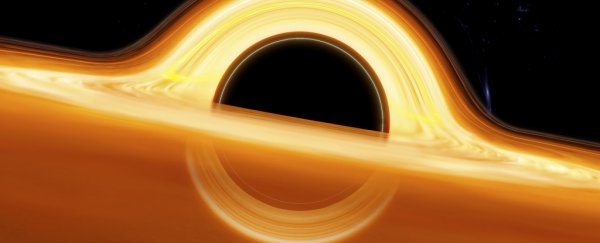The Universe may have more ways of forging heavy elements than we thought.
The creation of metals such as gold, silver, thorium, and uranium require energetic conditions, such as a supernova explosion, or a collision between neutron stars.
However, a new paper shows that these elements could form in the swirling chaos that rings an active newborn black hole as it swallows down dust and gas from the space around it.
In these extreme environments, the high emission rate of neutrinos should facilitate the conversion of protons to neutrons – resulting in an excess of the latter, required for the process that produces heavy elements.
"In our study, we systematically investigated for the first time the conversion rates of neutrons and protons for a large number of disk configurations by means of elaborate computer simulations, and we found that the disks are very rich in neutrons as long as certain conditions are met," said astrophysicist Oliver Just of the GSI Helmholtz Centre for Heavy Ion Research in Germany.
In the beginning, after the Big Bang, there weren't a lot of elements floating around. Until stars were born and started smashing together atomic nuclei in their cores, the Universe was a soup of mostly hydrogen and helium.
Stellar nuclear fusion imbued the cosmos with heavier elements, from carbon all the way up to iron for the most massive stars, seeded through space when the star dies.
But iron is where core fusion hits a snag. The heat and energy required to produce iron via fusion exceeds the energy the process generates, causing the core temperature to drop, which in turn results in the star dying in a spectacular kaboom – the supernova.
It's that spectacular kaboom (and the kabooms of colliding neutron stars) where the heavier elements are fused. The explosions are so energetic that atoms, colliding together with force, can capture neutrons from each other.
This is called the rapid neutron capture process, or r-process; it needs to happen really quickly, so that radioactive decay doesn't have time to occur before more neutrons are added to the nucleus.
It's unclear whether there are other scenarios in which the r-process can take place, but newborn black holes are a promising candidate. Namely, when two neutron stars merge, and their combined mass is sufficient to tip the newly formed object into the black hole category.
Collapsars are another possibility: the gravitational collapse of the core of a massive star into a stellar-mass black hole.
In both cases, the baby black hole is thought to be surrounded by a dense, hot ring of material, swirling round the black hole and feeding into it, like water down a drain. In these environments, neutrinos are emitted in abundance, and astronomers have long hypothesized that r-capture nucleosynthesis could be taking place as a result.
Just and his colleagues undertook an extensive set of simulations to determine if this is indeed the case. They varied the black hole mass and spin, and the mass of the material around it, as well as the effect of different parameters on neutrinos. They found that, if conditions are just right, r-process nucleosynthesis can take place in these environments.
"The decisive factor is the total mass of the disk," Just said.
"The more massive the disk, the more often neutrons are formed from protons through capture of electrons under emission of neutrinos, and are available for the synthesis of heavy elements by means of the r-process.
"However, if the mass of the disk is too high, the inverse reaction plays an increased role so that more neutrinos are recaptured by neutrons before they leave the disk. These neutrons are then converted back to protons, which hinders the r-process."
This sweet spot in which heavy elements are produced most prolifically is a disk mass between 1 and 10 percent of the mass of the Sun. This means that neutron star mergers with disk masses in this range could be heavy element factories. Since it's unknown how common collapsar disks are, the jury is still out for collapsars, the researchers said.
The next step will be to determine how the light emitted from a neutron star collision can be used to calculate the mass of its accretion disk.
"These data are currently insufficient. But with the next generation of accelerators, such as the Facility for Antiproton and Ion Research (FAIR), it will be possible to measure them with unprecedented accuracy in the future," said astrophysicist Andreas Bauswein of the GSI Helmholtz Centre for Heavy Ion Research.
"The well-coordinated interplay of theoretical models, experiments, and astronomical observations will enable us researchers in the coming years to test neutron star mergers as the origin of the r-process elements."
The research has been published in the Monthly Notices of the Royal Astronomical Society.
